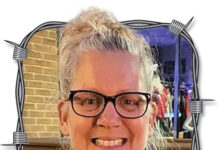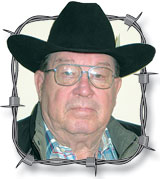The symbol of the American farm scene has been the red barn. The first farm I owned had one on it. And you can still see the old gable roof structure today on the right of I-540 before you drive uphill to the Bobbie Hopper Tunnel. There was something about buying an old, run down red barn. I had grown up on an Ozark farm and owning a red barn gave my partners Monty and Sumner Smith and I some pride. I can’t explain it now, but in the midst of all those persimmon sprouts, rundown fences and eroded patches of once-fields, there was always that barn.
People laughed at us taking on such a place. Sumner still had a year of college left at Arizona State University. Monty and I came back here from Arizona in August 1960. We needed work and Arkansas was desperate for schoolteachers in those days. So Monty and I taught school over in Huntsville the first year. I taught biology and he had the sixth grade.
Two big lanky cowboys and a great German Shepherd dog “Reb” came in a green Ford pickup truck to seek a new life. There was a gathering of folks over in Madison County at my wife-to-be Pat’s family’s house and while there, an overall-clad man gripping his suspenders came over and told me, “You boys will spend all your money and go back to Texas.”
I smiled at him and shook my head. “We didn’t come from Texas, we came from Arizona. We spent our last two dollars for gas in Tulsa and we’re here with you all.”
He didn’t know how close that was to the truth.
In our cowboy boots, tan jeans and pearl snap shirts, one lady thought we were wolf hunters and later told us that with a grin when she found out we were pretty harmless. A couple of drunks at a Legion hall dance were talking about starting a fight with us. My future brother-in-law Charles told them, “You better not, you ain’t only got to fight them big old boys, but that police dog of their’s will eat you alive.”
That extinguished the fight in them. To be honest Monty had told me earlier between songs that those drunks in the corner were giving us the eye for some trouble. It shocked me because Monty was the more peaceful one of the two of us — so I went to looking. I’d been way too busy dancing with Pat to notice much of anything.
That old red barn on our place had stalls for horses, a big feed room and stanchions for milk cows with a one-time concrete floor on the dairy side. The track was still overhead for the hayfork. I could visualize the system carrying fresh cut hay in and dumping it in the upstairs. But we never had the fork so the first two summers we filled it with pitch forks – a much less glamorous job than using the pulley system and a single horse out back doing the labor.
We stabled mares with colts in the barn, milked a few cows in it, raised lots of orphan calves, farrowed some sows, put our team of mules in it, kept some captured wild goats for a while before they escaped and many times we stood in the doorway watching rains come up the valley.
We shedded our first tractor inside the alleyway, stored our first baled hay in the loft and one night years later about 11 p.m. after hauling hay all evening to the barn, the two of us were hot and sweaty sitting in the mow door with our legs hanging over.
Sumner and I made a decisions for the partnership. I had to get up the next morning at 5 a.m. and be on the KFAY radio in the morning and then work all day for Tyson servicing chicken plus I still had an hour drive back to Springdale that night.
That late night under the stars we decided if we had to sell some cows we were buying a round baler. And we didn’t cut down anymore hay until we got it.
The old barn’s still there and I drive by and smile, knowing I once owned a real red barn.
Western novelist Dusty Richards and his wife Pat live on Beaver Lake in northwest Arkansas. For more information about his books you can email Dusty by visiting www.ozarksfn.com and clicking on 'Contact Us' or call 1-866-532-1960.






